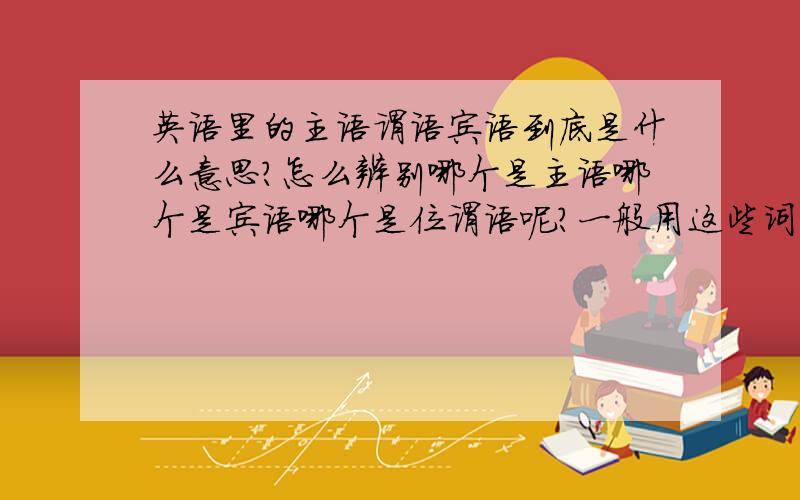英语里的主语谓语宾语到底是什么意思?怎么辨别哪个是主语哪个是宾语哪个是位谓语呢?一般用这些词有没顺序?比如说主语加动词之类的
来源:学生作业帮助网 编辑:作业帮 时间:2024/04/27 16:04:50

英语里的主语谓语宾语到底是什么意思?怎么辨别哪个是主语哪个是宾语哪个是位谓语呢?一般用这些词有没顺序?比如说主语加动词之类的
英语里的主语谓语宾语到底是什么意思?
怎么辨别哪个是主语哪个是宾语哪个是位谓语呢?一般用这些词有没顺序?比如说主语加动词之类的
英语里的主语谓语宾语到底是什么意思?怎么辨别哪个是主语哪个是宾语哪个是位谓语呢?一般用这些词有没顺序?比如说主语加动词之类的
主语是句子叙述的主体,可由名词、代词、数词、名词化的形容词、不定式、动名词和主语从句等来承担.
谓语说明主语所发出的动作或具有的特征和状态.谓语由动词来承担.
宾语是动作的对象或承受者,常位于及物动词或介词后面.宾语可由名词、代词、数词、名词化的形容词、不定式、动名词、宾语从句等来担任.
主语和谓语是英语句子的两大成分,除少数句子(如祈使句和感叹句等)外,一句话必须同时具有主语和谓语所表达的意思才能完整.主语是针对谓语而言的,是一句话的主题,谓语用来说明主语的情况,为主语提供信息.例如:They are working.主语是they(他们),那麽他们在做什麽呢?看来没有谓语are working 是不行的.在正常情况下,英语的主语和谓语的位置与汉语一致,也就是说主语在前,谓语紧跟其后.那麽,哪些词语可以做主语,谓语,何时主谓倒置,主语与谓语的一致情况如何,我将一一讲述.
一、哪些词可以充当主语
1,名词
例如: A mooncake is a delicious, round cake.
The first truck is carrying a few baskets.
The temperature will stay above zero.
The doctor looked over Mrs. Brown very carefully.
China does not want to copy the USA’s example.
2,代词
例如: It’s a young forest.
I don’t know if it will grow.
That’s a bit expensive.
You’d better buy a new pair.
I’m afraid we haven’t got any black shoes.
3,数词
例如:One and two is three.
One is not enough for me. I want one more.
One of them is English.
Suddenly one of the bags fell off the truck.
Two will be enough.
4,不定式 (常以 It’s adj. to do sth. 形式出现)
例如: To give is better than to receive =Its better to give.
I found it difficult to get to sleep.
It’s glad to see you again.
It was difficult to see.
But it’s good to swim in summer.
5,IT 作主语,有如下情况:
1)指代刚刚提到的事物:What’s this ? It’s a bus. (指代what)
2)指代一个你不知道或判断不清性别的人:Who’s knocking the door? It’s me. (指代 who)
Who’s the baby in the picture? It’s my sister. (指代 who)
3) 表示时间,天气,距离:
What’s the time? It’s eight o’clock. (时间)
What’s it going to be tomorrow? It’s going to be rainy.(天气)
How far is it? It’s about one kilometre away. (距离)
6. THERE 引起的There be 句型中,be 作谓语,主语位居其后.如:
There are many different kinds of mooncakes.
There will be a strong wind.
二、谓语
谓语有动词构成,依据其在句中繁简程度可把谓语分为简单谓语和复合谓语两类.不论何种时态,语态,语气,凡由一个动词(或动词词组)构成的谓语都是简单谓语.例如:
I like walking.(一般现在时主动语态)
I made your birthday cake last night. (一般过去时主动语态)
It is used by travellers and business people all over the world. (一般现在时被动语态)
复合谓语也可分为两种情况:
第一种是由情态动词,助动词+不带to的动词不定式构成的复合谓语:
What does this word mean?
I won’t do it again.
I’ll go and move away the bag of rice with Lin Tao.
You’d better catch a bus.
第二种是由连系动词+表语构成的复合谓语.例如:
You look the same.
We are all here.
The weather gets wamer, and the days get longer.
Keep quite and listen to me.
He looked worried.
We have to be up early in the moming.
Is Bill in?
School Is over. Let’s go home.
My pen is in my bag.
I feel terrible.
I* fell tried all the time.
He seemed rather tired last night.
连系动词和表语在意思上紧密联系,不宜分割;有关动词的种类这方面知识在课本中已有介绍,此处不多说了.
三、主语与谓语的一致
英语句子的主语和谓语的一致性,是英汉两种语言的区别之一.具体说来有如下特征:
1, 谓语动词在人称和数上应与主语保持一致.如:
Now the teacher comes into the classroom.
本句属一般现在时,主语the teacher 为第三人称单数,因而谓语动词come 应加s.
One morming she was working at her desk in the library wher a boy came in. 本句属主从复合句,主句用过去进行时,从句为一般过去时;主句中主语she为第三人称单数,所以谓语为 was working.
1) 主语含有 and 时,如表示一个单一的概念,谓语动词常用单数(特别是当and 连接的是两个不可数名词时),否则用复数.如:
One and three is four. And 前后均为数字,表示同一个概念,谓语动词应用is.
Tea and milk is my favourite drink. 本题中tea and milk 指一种饮料,故谓语用is.
Tom and Li Lei are my best friends. Tom 和 Li lei 是完全不同的两个人,有不同的特征,因而谓语是are.
2) 主语为动词不定式时,其谓语常用单数形式.如:
To give is better than to receive.
It was difficult to see.
It’s best to wear cool clothes.
同样,动名词作主语,谓语动词也为单数.初中阶段只学了一句:
It (playing) is much better than having classes.
3) 不可数名词作主语,谓语动词视为单数.如:
The best time to come to China is autumn.
The weather in England never gets too hot.
4) 在姓的复数前加the 表示一家人,谓语动词为复数.如:
What time do the Reads have breakfast? 主语是the Reads, 表示里得一家人,谓语动词用do….have.
5) 表示时间的复数名词作主语,常作整体看待,其谓语动词为单数形式.如:
Two months is quite a long time.
6) “几加几等于几”的算式中,谓语动词常为单数.如:
Twenty and forty is sixty.
主 谓
7) 某些表示学科的名词作主语,无论其结尾是什麽,谓语动词都视为单数.如:
Maths is my favourite subject.
主 谓
8) each 以及由some,any,no,every 构成的复合代词作主语,谓语动词为单数.如:
There’s something wrong with my ears!
谓 主
Everyone is going into class.
主 谓
9) what,who which 等词做主语,谓语动词形式视意思而定.如:
What is this?(this 为单数,用is)
What are these? (these 为复数,用are )
Which is your friend? 哪一个人是你的朋友?
Which are your friends? 哪些人是你的朋友?
10) None 作主语,其谓语可以是单数,也可以是复数,此项目并非初中阶段重点,故此不谈.
11) People,Chinese, Japanese 作主语,谓语动词为复数.如:
There are four people in my family.
谓 主
The chinese people are very friendly.
12) population 作主语,指“人口”时,谓语为单数;其前有表示数量的修饰语时,谓语为复数;课本第三册只要求掌握作“人口”讲时谓语的情况:
What’s the population of Germany?
谓 主
What was the population of the world in 1950?
谓 主
Half of the population of China are women.
修饰语 主 谓
2, 由 either …or 或neither …nor 连接的两个并列成分作主语,其谓语动词形式与后一个主语保持一致.如:Either Lily or Lucy is going to come.(Lily和Lucy 谁去都行.后一个主语Lucy 为第三人称单数,谓语用is going to come.)
Either I or he does well in English. 我和他的英语都不错.
Neither I nor she likes swimming. 我和她都不喜欢游泳.
由these 和here 引出的含有不只一个主语的句子,其谓语动词形式由最靠近谓语的主语形式决定.如:
These is a pen, two rulers and three books on the desk.
Here are some cups,a glass and some pears on